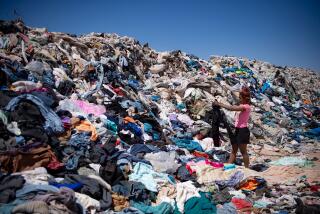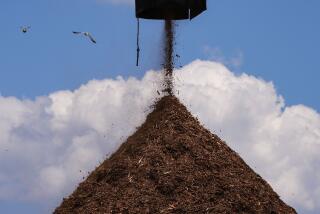Latin America Takes Steps to Stop Toxic Imports From U.S. : Environment: Everything from household trash to radioactive sludge is dumped in the region, causing a variety of life-threatening disorders.
SAO PAULO, Brazil — U.S. and European companies dump millions of tons of toxic waste in Latin America every year, leaving poisonous residues that health officials say will endanger lives for decades.
Everything from household trash to radioactive sludge is sent to the region because lax anti-pollution laws make disposal easier and cheaper.
Waste exporters say they are doing nothing wrong, but environmentalists claim that Latin Americans are not being told the full story behind the toxic garbage they receive.
Scientists in Brazil say the toxic waste, dumped haphazardly in rivers, marshlands or earth wells since the late 1960s, causes cancers, birth defects, nerve damage and blood disorders.
“This is an illicit trade, shrouded in secrecy and often done by small unregistered companies, that is devastating the environment and will affect generations to come,” said Dr. Anthony Wong, president of the Brazilian Society of Toxicology and director of the Sao Paulo Poison Control Center.
No precise figures are available for Latin America, but Mostafa Tolla, director of the U.N. Environmental Program, estimates that 40 million tons of toxic waste entered the Third World in 1989.
The United States, which generates 275 million tons of hazardous garbage a year, is the world’s leading waste exporter.
American companies wanting to export hazardous waste must tell the Environmental Protection Agency.
Such notifications rose from 12 in 1980 to 626 in 1989. A growing share of the waste went to Brazil, Mexico, Argentina and the Caribbean, according to EPA documents.
“Latin America is a perfect dumping ground,” said Rubens Born, director in Brazil for Greenpeace, the international environmental group. “There’s lots of space, loads of corrupt inspectors and widespread ignorance of the problem.”
Waste exporters say wastes are tightly monitored by the EPA and shipments could not leave the United States if they contained dangerous levels of toxins. They also say the disposal methods they practice in foreign countries are comparable to those in the United States.
Latin health officials argue that poorly paid, ill-equipped port inspectors are easily bribed to sign consent forms for importing hazardous waste or to look the other way when cargoes are disposed of illegally.
U.S. law says foreign countries must be notified about waste shipments, but many Latin governments complain about the quality of the information.
“The information we receive from the U.S. EPA is grossly misleading,” said Dr. Waldemar F. Almeida, head of Brazil’s National Institute of Health Quality Control. “We are rarely informed of the quantity, the type of waste or its destination.”
Wendy Grieder, director of the EPA’s international office in Washington, responded in a telephone interview:
“Waste is shipped with the understanding of all countries involved. Latin countries are told through our embassies what kind of waste they are getting, how much and the point of exit and entry.”
A 1988 report by the EPA inspector general said, however, that the agency did not know how much waste was shipped abroad or which exporters failed to comply with requirements for notification of intent.
Foreign firms often approach debt-ridden Latin governments with offers of public works projects or increased investment in return for permission to dump waste.
In 1988, a New York company offered to build schools, hospitals and roads in San Clemente, Peru, in return for the right to dispose of incinerator ash near the city. After public protests, Peruvian officials rejected the offer.
On July 7, 1989, Summit Cement & Development Corp. asked the Bahamian government for permission to blend 88,000 tons a year of hazardous solvents with prime fuels to fire cement kilns on Grand Bahama Island, according to company documents.
In return, Summit promised to create 180 jobs and give $4.5 million to the Caribbean island. The government turned the offer down.
“Hazardous wastes would have been unloaded and burned 50 yards from where cruise ships dock in the harbor,” said Edward St. George, chairman of the Bahamas Port Authority. “For a few jobs, we would have polluted the island and severely damaged our reputation with tourists.”
The Associated Press telephoned several times to the office of the company owner, Finn Moller, in Alhambra. His secretary said he would have no comment.
Chile, Argentina, Guatemala and Bolivia have received offers from U.S. and European companies to build incinerators and dump sites for foreign waste, government officials of those countries told the AP. All offers were refused.
Jim Vallette, a Greenpeace coordinator in Washington, said: “These governments have so far resisted pressure to enter potentially lucrative dumping contracts because nationalists will accuse them of pandering to Uncle Sam’s interests.”
Environmentalists say the cash offers are tempting for Latin American governments, which have a combined foreign debt of more than $400 billion.
“We are being forced to choose between poverty and poison,” said Juan Shroder, founder of the environmental group Earth Alert in Buenos Aires.
Some waste is intended for use in development projects.
In January, International Energy Resources Inc. of Greenwich, Conn., offered to underwrite the cost of resurfacing 400 miles of roads in Guatemala with 5.5 million tons of ash from U.S. municipal incinerators.
The government backed out after Greenpeace told Guatemalan authorities the ash contained dangerous levels of arsenic, cadmium and mercury.
Douglas Berardo, president of the company, said that the chemicals did not pose a health or ecological threat because the ash had been “washed” and that what toxicity remained would be immobilized when the ash was mixed with concrete.
“Everything was done according to the EPA’s specifications,” he said. “This ash is clean.”
More to Read
Sign up for Essential California
The most important California stories and recommendations in your inbox every morning.
You may occasionally receive promotional content from the Los Angeles Times.










